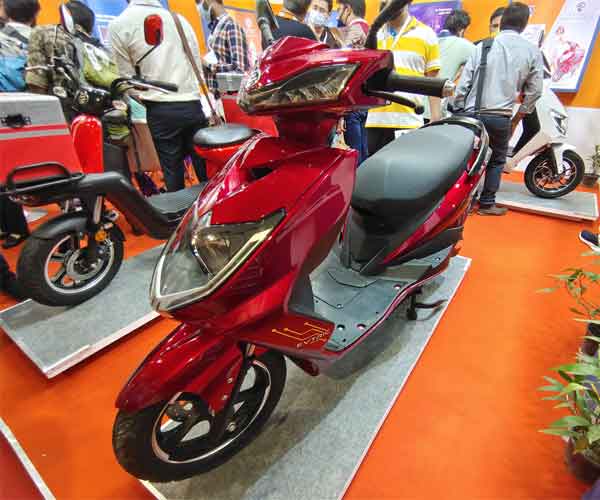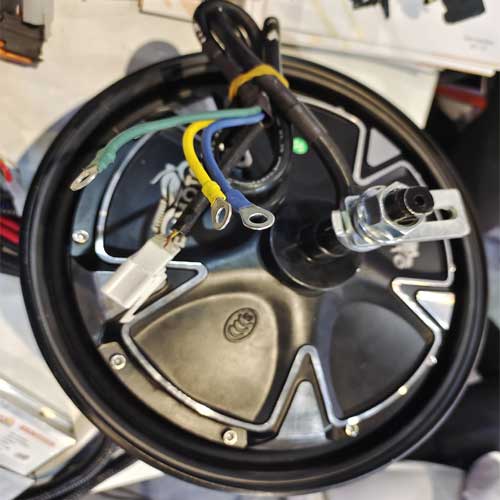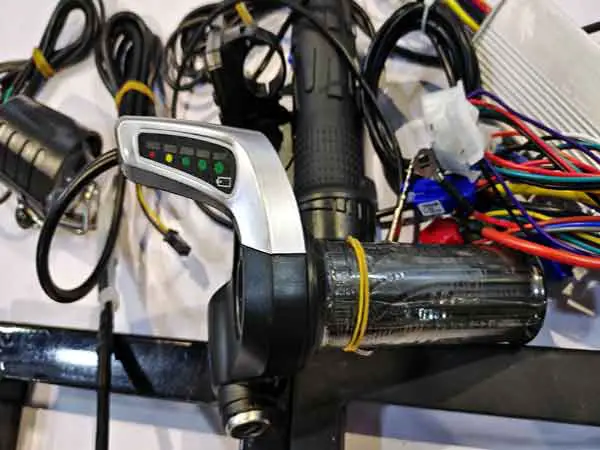What is an E-scooter or E-Motorcycle?
An E-2-wheeler is a type of electric two-wheeler – a purely electric vehicle. It includes an e-scooter, e-motorcycle, e-moped, e-bike, &/or an e-bicycle. It neither has an engine nor uses fossil fuels such as petrol, diesel, or CNG to run. Instead, it uses only electricity to power and run itself. Generally, it has a rechargeable battery to store the electric energy and propel the 2-wheeler. So, you can say that a 2-wheeler that uses only electricity to run is called the E-2-wheeler, E-scooter, or E-Motorcycle.

Components:
- Battery
- Hub-Motor
- Controller
- Electric Throttle / Accelerator
- Cables
- Control panel / Switches
- Charging device / Fast charger
- Digital Display
- Pedal Assist Sensor (PAS) in e-bicycles
- Battery Management System (in some e-scooters)
How an E-scooter or E-Motorcycle works?
Instead of an internal combustion engine, an e-scooter gets its power from an electric motor. The DC battery provides current to the electric motor, which sits inside the wheel hub. Manufacturers call this set up as ‘Hub-Motor.’ Usually, the hub motor is a part of the rear wheel. The wheel also features a drum or a disc to hold braking system components. Thus, it is a compact unit with a motor and braking system parts assembled next to it.

The cable for supplying the electric current to the motor comes out from the center of the hub. It connects to the battery thru a controller and an electric throttle/accelerator. When you turn on the ignition, the battery draws electric current to the hub-motor thru’ controller and an electric throttle.
Furthermore, the current increases as you increase the accelerator. Then, the hub motor starts to spin, moving the e-scooter forward. However, most E-scooters don’t come with transmission or gears. Therefore, it reduces the weight and cost of manufacturing the scooter. Instead, the motor itself has variable speeds that you can control thru’ the electric throttle/speed switch.

Electric Throttle
Performance:
Also, there are riding modes such as Eco, Power, and Sport for different types of performances. However, the battery range differs depending on the riding mode. For example, your e-scooter will go more miles in the Eco mode than the Sport mode. However, Eco mode will restrict the speed to the minimum, while Sport mode will deliver maximum speed but low mileage.
Therefore, the E-scooters or E-Motorcycles are in no way less than the conventional scooters in terms of power, speed, and acceleration (pick-up or torque). In addition, most e-scooters offer a unique feature of ‘reverse’ function. Since the motor itself spins in both directions, you can reverse the scooter for a short distance by switching on the ‘reverse’ switch. Some advanced E-scooters also feature a Regenerative Braking system for additional mileage.
Power/Wattage:
The performance of an e-scooter mainly depends upon the wattage rating of the electric motor. The higher the wattage better the performance. E.g., the electric motor’s power output hugely affects the load-carrying capacity and gradability of an e-scooter. So, be careful while choosing your next e-scooter. Low-wattage scooters could be cheaper to buy. However, they may not meet the expected performance levels. According to the industry experts, for better performance & carrying two passengers needs at least a 200-250W electric motor.
The Battery Wattage:
A kilowatt-hour is a composite unit of energy equal to one kilowatt (kW) times one hour. If expressed in the standard unit of energy in the International System of Units (SI), the joule (symbol J) is equal to 3600 kilo-joules (3.6 kJ). Watt Hour is the battery capacity that could give out the specified energy for one hour. After that, it drains out. However, if the battery gives out more power, it discharges faster.
E.g., if a battery’s rating is 100WH, it means that the battery could give out 100watts (i.e., 12v*8.33A) for one hour. But, if the load draws 16amps (i.e., 192 watts), it could give out its energy only for half an hour. So, if the current load doubles, its discharge time reduces to half, and so on. Thus, simply put, it indicates how long your battery would last after charging.
Maintenance:
Although the manufacturers claim that an e-scooter or an e-motorcycle does NOT need any maintenance, it may not be the case. It mainly depends upon its design. For example, some vehicles may be installed with a manual or an automatic gearbox mechanism, while others may have a CVT unit.
Although an e-scooter does NOT have an engine, they have an electric motor to drive itself. The motor parts, such as the bearings, could wear off. Its rotor & armature could go faulty. Besides, the e-scooter may also need a brake adjustment & even suspension settings are checked & adjusted. Sometimes, even the battery cells may need repairs/replacements.
All these things account for the service/maintenance issues. So, be aware of these things well before you buy an e-vehicle. Also, make sure that the service station/dealer is closer to you. Preferably, an e-vehicle manufacturer is close to your city/town so that the required parts reach you in time. And, your vehicle does NOT hold up for want of necessary parts/components. Or else, you may end up keeping your e-vehicle in the garage most of the time, rather than using it…!
Development:
The e-scooter is still in the developing stage. Some battery manufacturers are working on further improving the fast-charging capabilities of batteries. Currently, many old and new scooter-makers are already working on their e-scooters. However, Gogoro, Ola, And Ather are some of the popular e-scooter manufacturers in the world.
